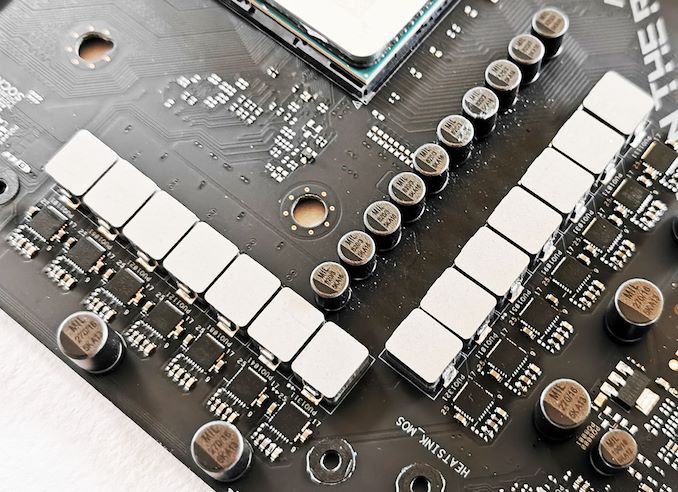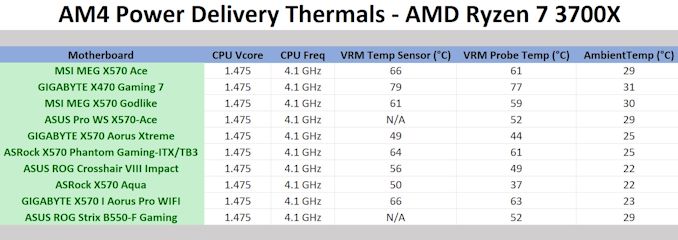The ASUS ROG Strix B550-F Gaming Wi-Fi Motherboard Review: Premium Value
by Gavin Bonshor on July 22, 2020 9:00 AM EST- Posted in
- Motherboards
- AMD
- Asus
- ROG
- AM4
- Strix
- Ryzen 3000
- Ryzen 3700X
- B550
- B550-F
Power Delivery Thermal Analysis
One of the most requested elements of our motherboard reviews revolves around the power delivery and its componentry. Aside from the quality of the components and its capability for overclocking to push out higher clock speeds which in turn improves performance, is the thermal capability of the cooling solutions implemented by manufacturers. While almost always fine for users running processors at default settings, the cooling capability of the VRMs isn't something that users should worry too much about, but for those looking to squeeze out extra performance from the CPU via overclocking, this puts extra pressure on the power delivery and in turn, generates extra heat. This is why more premium models often include heatsinks on its models with better cooling designs, heftier chunks of metal, and in some cases, even with water blocks.

The 14-phase power delivery operating at 4+2 on the ASUS ROG Strix B550-F Gaming Wi-Fi
The ASUS ROG Strix B550-F Gaming Wi-Fi is equipped with a fourteen phase power delivery with fourteen SiC639 50 A power stages which is split into twelve for the CPU, and two for the SoC. It is using a an ASP1106JGQW 6-phase PWM controller which is operating in a 4+2 configuration. ASUS has opted for teamed power stages with three power stages per channel for the CPU, which should, in turn, reduce the overall VRM temperatures without sacrificing on power.
Testing Methodology
Out method of testing out if the power delivery and its heatsink are effective at dissipating heat, is by running an intensely heavy CPU workload for a prolonged method of time. We apply an overclock which is deemed safe and at the maximum that the silicon on our AMD Ryzen 7 3700X processor allows. We then run the Prime95 with AVX2 enabled under a torture test for an hour at the maximum stable overclock we can which puts insane pressure on the processor. We collect our data via three different methods which include the following:
- Taking a thermal image from a birds-eye view after an hour with a Flir Pro thermal imaging camera
- Securing two probes on to the rear of the PCB, right underneath CPU VCore section of the power delivery for better parity in case the first probe reports a faulty reading
- Taking a reading of the VRM temperature from the sensor reading within the HWInfo monitoring application
The reason for using three different methods is that some sensors can read inaccurate temperatures, which can give very erratic results for users looking to gauge whether an overclock is too much pressure for the power delivery handle. With using a probe on the rear, it can also show the efficiency of the power stages and heatsinks as a wide margin between the probe and sensor temperature can show that the heatsink is dissipating heat and that the design is working, or that the internal sensor is massively wrong. To ensure our probe was accurate before testing, I binned 10 and selected the most accurate (within 1c of the actual temperature) for better parity in our testing.
For thermal image, we use a Flir One camera as it gives a good indication of where the heat is generated around the socket area, as some designs use different configurations and an evenly spread power delivery with good components will usually generate less heat. Manufacturers who use inefficient heatsinks and cheap out on power delivery components should run hotter than those who have invested. Of course, a $700 flagship motherboard is likely to outperform a cheaper $100 model under the same testing conditions, but it is still worth testing to see which vendors are doing things correctly.
Thermal Analysis Results

We measured 54.9°C on the hottest part of CPU socket area during our testing
To cool the power delivery on the Strix B550-F Gaming Wi-Fi motherboard, ASUS is using a pair of heatsinks which aren't connected with a heat pipe. This means each heatsink is cooling different parts of the heatsink without distributing the heat between each other. Running our VRM thermal test yields a very favorable result for the B550-F Gaming Wi-Fi, with a maximum temperature of 52°C on our K-type thermal probe. This is backed up with our FLIR thermal imaging camera which measured 54.9°C on the hottest part of the area around the power delivery and the CPU. This represents fantastic performance, especially for a B550 series motherboard, and shows that the ASUS power delivery very efficient and well designed.











40 Comments
View All Comments
shaddixboggs - Wednesday, July 22, 2020 - link
I won't give a dollar to ASUS for an AMD product. They've crapped the bed one too many times at this point.Alim345 - Wednesday, July 22, 2020 - link
Are higher benchmark scores of some boards are due to default bios configuration or beefier power delivery systems?deadstardragon - Wednesday, July 22, 2020 - link
Page 4 - Board Features - "For users looking to use compatible Ryzen APUs, there's an HDMI 2.1 and DisplayPort 1.2 output pairing"Correct me if I'm wrong, but I thought this MOBO had an onboard integrated graphics processor thus circumventing the need for a specific Ryzen APU. Given that, could you not use, say, a Ryzen 7 3700X like in your test setup and still take advantage of the onboard HDMI/DP?
mr0vka - Wednesday, July 22, 2020 - link
Has anyone read the article before posting? Are anandtech authors paid based on a numer of characters? This article contains multiple typos, and then (which is really irritating) multiple repetitions of the whole sentences across the article. In one place the only change in the whole paragraph that is being duplicated is “AMD” changed to “AM4”.WTH!?
supdawgwtfd - Thursday, July 23, 2020 - link
You must be new here...Has been an ongoing issue for years now.
It's to be expected when they have no editor.
PeachNCream - Thursday, July 23, 2020 - link
Anandtech has been dropping that ball for a good half decade or more. Part of the problem is article and table standardization through the use of prior articles and tables. That invariably results in mistakes when clearing old data before entering new information. Those sorts of errors show up constantly making it very clear there is lots of copy and paste sorts of slapdash happening behind the curtain. Professional writers and good editorial proofing are things you should look elsewhere to find.quantumshadow44 - Thursday, July 23, 2020 - link
pathetic. With msi x570 tomahawk msrp $210 this board has no chances.danjw - Sunday, August 2, 2020 - link
I think it would be better to list deltas from ambient in the VRM temperature chart. Since that is the real data, save users from having to do the math in their head. ;-)Also, I would really like to see Linux benchmarks added.
DiYBeast - Thursday, September 17, 2020 - link
Love it Asus rog makes the best top their boards